Whatever the reason you might want a radar detector, there’s no judging here. After all, these handy devices are good for a lot more than dodging a speeding ticket. In fact, the biggest reason someone might want a radar detector is the data. You see, radar detectors can help you be more aware of your surroundings and what’s happening as you embark on a cross-country road trip or your daily commute. Like a dash cam, a radar detector protects you from possible mishaps and makes your drive safer.
“Radar detectors, I’ve found, are just a good way of understanding what’s going on around you and adding some additional situational awareness,” explains Ariel Bravy, who runs VortexRadar.com. With a background in electrical and computer engineering, Bravy has been posting in-depth tests of radar detectors and other automotive accessories on YouTube since 2012. He adds, “I love driving. I love feeling secure while I’m driving — just knowing what’s going on around me — and I love tech stuff.”
Watch this: What’s the best radar detector?
Before we dive in, we suggest you do a little research about radar detectors and their technology. Even the simplest products in the category require education in some basic vocabulary. To reach the full potential of your new detector, you’ll have to know your K band from your Ka band and whether you’re driving through a state where you should enable X band. Further, you should think about what sort of features you’re looking for, from highway mode to a red light camera alert to directional alerts.
Here are our top picks for the best radar detectors for different scenarios based on hands-on testing, expert input and user reviews. Further on, we’ll answer some frequently asked questions and tell you what to watch out for when choosing a detector, including the sad truth about laser detection.

 \n ","topic":"","ttag":"","variant":"","viewguid":"","event":"listicle|image|1","correlationId":"","_destCat":"https:\/\/store.valentine1.com\/Store\/item.asp?i=20020","productName":"Best radar detector overall","formatType":"IMAGE","location":"LIST","position":1,"sku":"","dwLinkTag":"article-body|listicle|image","selector":"#article-body #listicle-2e0d82dd-3e7a-4ae0-b523-e9f61ee642bd .itemImage"}}” rel=”noopener nofollow” target=”_blank”>
\n ","topic":"","ttag":"","variant":"","viewguid":"","event":"listicle|image|1","correlationId":"","_destCat":"https:\/\/store.valentine1.com\/Store\/item.asp?i=20020","productName":"Best radar detector overall","formatType":"IMAGE","location":"LIST","position":1,"sku":"","dwLinkTag":"article-body|listicle|image","selector":"#article-body #listicle-2e0d82dd-3e7a-4ae0-b523-e9f61ee642bd .itemImage"}}” rel=”noopener nofollow” target=”_blank”>
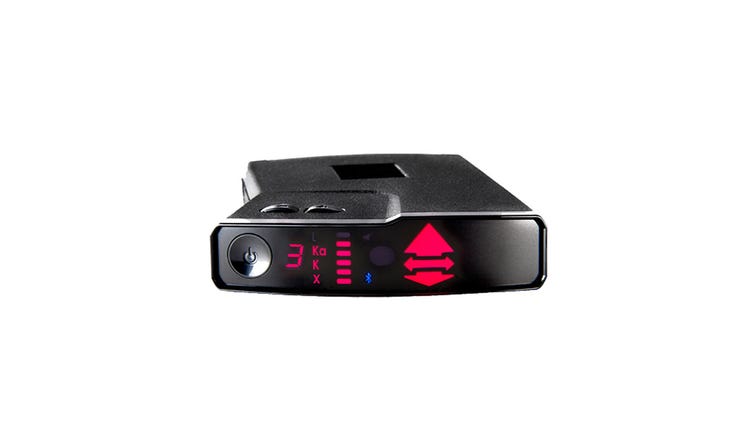

Valentine One
At first glance, you’d be forgiven for thinking the Valentine One Generation 2 was a gadget from a bygone era. With its matte black, slab-sided industrial design, conspicuous lack of buttons and, yes, even a segmented LED readout instead of a full-color OLED display, it looks like it could have been hanging from your sun visor since the early ’90s.
But that’s sort of the point. This Gen2 device has been a long time coming, the first all-new upgrade to the legendary Valentine One product line in nearly 30 years. If you know the classic Valentine One, made famous by its game-changing directional radar detection, then you know exactly what you’re looking at when you see the Generation 2.
Valentine actually calls its device a “radar locator” because when it picks up a signal from X, K, Ka or laser, one of three prominent directional arrows lights up to indicate whether the radar signal is coming from ahead, beside or behind.
Until you start using it, this bit of data may seem trivial, but you quickly realize how helpful it is to know where to look for possible signs of trouble. If the front arrow lights up, police could be around the bend. But, should the side arrows glow red, your “bogey” (as Valentine refers to radar hits) is more likely a false alarm from another car or an automatic door — police measure your speed from the front or behind, not the side.
There’s a wrinkle: Now that the company’s patent on arrows has expired, this is no longer an exclusive feature, and a slew of other mid- to high-end detectors can come with directional indicators. What makes the Valentine One Generation 2 a true stand-out is adding competitive long-range detection, top-notch false positive filtering, Bluetooth and an open API to its already impressive skillset.
Focusing on its built-in smarts, if you’re used to more chatty, inexpensive radar detectors, you may be compelled to ask, as we did, whether the V1G2 is even working. Where other units beep and boop indiscriminately with little indication of where potential threats are coming from, Valentine’s hardware stays pleasantly silent but vigilant, only speaking up when a bogey is a legitimate concern.
Still, most notable among its few shortcomings is a lack of GPS integration. Where other detectors use location tracking to lock out non-law enforcement sources of radar pollution, Valentine relies on its advanced algorithms to do the filtering on the fly. They say the minor advantages GPS provides aren’t worth the extra cost to consumers, and in any case, Bluetooth app integration brings location data and more to the party if you have your smartphone nearby.
Pair the V1G2 with one of the various apps available on Android or iOS, and the unit’s capability and features extend well beyond anything baked into the hardware. This makes for what we think is a winning combination for most drivers.
Let’s go back to that old-school segmented LED we mentioned earlier. As we’ve said, radar detectors are about data. The company kept the LED because it’s much easier to read in sunlight than fancier, multicolor read-outs, and that’s emblematic. The Valentine One Gen2 is all about providing the most relevant information in the clearest, simplest terms — no frills, just well-honed skills.

 \n ","topic":"","ttag":"","variant":"","viewguid":"","event":"listicle|image|2","correlationId":"","_destCat":"https:\/\/www.amazon.com\/dp\/B07PJ2ZX6R","productName":"Best radar detector runner-up","formatType":"IMAGE","location":"LIST","position":2,"sku":"","dwLinkTag":"article-body|listicle|image","selector":"#article-body #listicle-1907f58b-bbd6-4c1c-98d5-aecb6fd6cca3 .itemImage"}}” rel=”noopener nofollow” target=”_blank”>
\n ","topic":"","ttag":"","variant":"","viewguid":"","event":"listicle|image|2","correlationId":"","_destCat":"https:\/\/www.amazon.com\/dp\/B07PJ2ZX6R","productName":"Best radar detector runner-up","formatType":"IMAGE","location":"LIST","position":2,"sku":"","dwLinkTag":"article-body|listicle|image","selector":"#article-body #listicle-1907f58b-bbd6-4c1c-98d5-aecb6fd6cca3 .itemImage"}}” rel=”noopener nofollow” target=”_blank”>
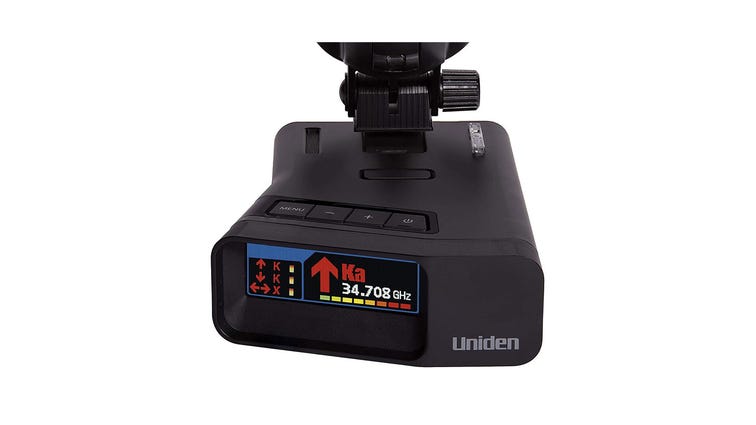

Uniden
The Uniden R7 may just make you do a double-take. Its black, angular design answers the question of what the Valentine One would look like if it had sprung for an OLED screen. In truth, it’s a dead heat between these two detectors, and depending on your needs, the R7 may just be the one to get. This laser detector comes with built-in GPS, voice alert, red light cameras and speed camera alerts.
In terms of range, the V1G2 and the R7 are neck-and-neck. In independent tests performed by Vortex Radar, the alert distance varied by only 200 to 300 feet between the two detectors with Uniden’s offering occasionally winning out, depending on the band and configuration. Both outclassed the majority of contenders by a wide margin.
Like our favorite pick on this list, the R7 offers directional arrows to indicate where radar hits are coming from. In this case the arrows are rendered on a small color display, which is slightly hooded from direct sunlight.
In addition to the typical radar bands, X, K and Ka, the Uniden R7 can detect the newer MultaRadar variant as well as laser. Voice alerts are also on offer here, as are configurable alert tones for the different bands. Set alerts to notify you to speed zones, speed traps, construction zones and school zones. As with other high-end detectors, the R7 claims undetectability from certain radar detector detectors (RDDs), specifically the Spectre I and IV.
But, the killer app here may be built-in GPS, a feature missing from the otherwise full-featured V1G2. The addition of location awareness allows you to manually or automatically store up to 2,000 lockouts where false alerts repeatedly ping your detector in regular driving. GPS also enables the R7 to alert you to red light camera locations stored in Uniden’s database, updateable via USB.
What the R7 gains in GPS ability it trades for Bluetooth connectivity. In one of its few omissions, Uniden has opted not to include a wireless standard for connecting your phone, which means fewer options for data aggregation with other radar users. For this, you’ll need to turn to a third-party app such as Waze, which is free but no less excellent.
There’s not much that disappoints about the Uniden R7, and at a street price that frequently beats the Valentine One, it’s hard to go wrong.

 \n ","topic":"","ttag":"","variant":"","viewguid":"","event":"listicle|image|3","correlationId":"","_destCat":"https:\/\/shareasale.com\/r.cfm?b=999&u=514792&m=50974&afftrack=[subid_value]&urllink=www.escortradar.com%2Fproducts%2Fescort_redline_360c","productName":"Best radar detector if money is no object","formatType":"IMAGE","location":"LIST","position":3,"sku":"","dwLinkTag":"article-body|listicle|image","selector":"#article-body #listicle-5d1ff48c-5c06-4d04-bf5c-eaa581aeb475 .itemImage"}}” rel=”noopener nofollow” target=”_blank”>
\n ","topic":"","ttag":"","variant":"","viewguid":"","event":"listicle|image|3","correlationId":"","_destCat":"https:\/\/shareasale.com\/r.cfm?b=999&u=514792&m=50974&afftrack=[subid_value]&urllink=www.escortradar.com%2Fproducts%2Fescort_redline_360c","productName":"Best radar detector if money is no object","formatType":"IMAGE","location":"LIST","position":3,"sku":"","dwLinkTag":"article-body|listicle|image","selector":"#article-body #listicle-5d1ff48c-5c06-4d04-bf5c-eaa581aeb475 .itemImage"}}” rel=”noopener nofollow” target=”_blank”>
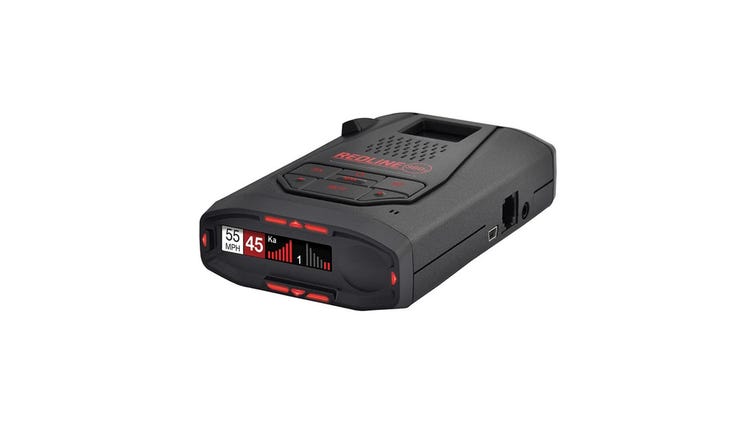

Escort
If “budget” isn’t in your vocabulary, you simply can’t go wrong with the Escort Redline 360c. This beast of a radar detector has no interest in aping the black box aesthetic of its top-of-the-line competition. Instead, it’s stylish with interesting contours and it’s a hefty bit of machinery to boot. It mounts to the windshield using a magnet attachment point that’s as powerful and secure as it is easy to decouple when you want to store the device away from prying eyes.
Getting the basics out of the way, the Redline 360c detects all the common radar bands and adds MultaRadar to that as well as laser. Like the Valentine One and the Uniden R7, the Escort radar detector is directional and features four LED arrows around the front perimeter of the device that indicate whether signals are coming from the front, sides or rear.
Inside that perimeter is a customizable multicolor OLED screen. This includes a simple Novice mode, which dispenses with signal strength indicators and band information and replaces it with color-coded bars, which say things like “Slow Down” and “Caution.”
But does it also have GPS? Yes. And Bluetooth? Yes. Wi-Fi? Yes. It’s also RDD immune and can expand its capability further by controlling Escort’s laser jammers, sold separately. Its false alert filtering is among the best in the business, and its range meets or exceeds both the V1 and R7.
GPS affords the 360c all the usual goodies: low-speed muting, red light camera alerts as well as automatic lockouts. Additionally, in Auto Mode it uses GPS to monitor your speed and ramps its filters up to eliminate unnecessary noise when you’re in town or in a parking lot. As with the V1, you may question whether this Escort is even working at times because it’s so good at only bothering you when the threat is genuine.
On top of all that, the Redline 360c allows you to take the experience to the next level with its Escort Live app, which connects via Bluetooth. While the app is proprietary, unlike Valentine’s open API implementation, it does allow you to tap into the hivemind of Escort and Cobra radar users. You can be alerted of speed traps and other threats in real-time while they are still outside of detection range. And when you’re connected to the app the current speed limit is displayed on the Redline’s screen next to your actual speed, allowing for customizable overspeed alerts.
In our testing, the app integration was perhaps the only major weakness of the Escort Redline 360c. It would occasionally disconnect from Bluetooth, requiring a reboot of the app. Also, the speed limit information was frequently inaccurate with Waze doing a much better job of displaying the correct limits. Nevertheless, if you’ve got the money for it, this radar detector is the full package and absolutely the one I’d choose.

 \n ","topic":"","ttag":"","variant":"","viewguid":"","event":"listicle|image|4","correlationId":"","_destCat":"https:\/\/www.amazon.com\/dp\/B0743H6CSN","productName":"Best midrange radar detector","formatType":"IMAGE","location":"LIST","position":4,"sku":"R3DSP","dwLinkTag":"article-body|listicle|image","selector":"#article-body #listicle-2f68dccb-e328-4923-806e-3be29dfcf066 .itemImage"}}” rel=”noopener nofollow” target=”_blank”>
\n ","topic":"","ttag":"","variant":"","viewguid":"","event":"listicle|image|4","correlationId":"","_destCat":"https:\/\/www.amazon.com\/dp\/B0743H6CSN","productName":"Best midrange radar detector","formatType":"IMAGE","location":"LIST","position":4,"sku":"R3DSP","dwLinkTag":"article-body|listicle|image","selector":"#article-body #listicle-2f68dccb-e328-4923-806e-3be29dfcf066 .itemImage"}}” rel=”noopener nofollow” target=”_blank”>
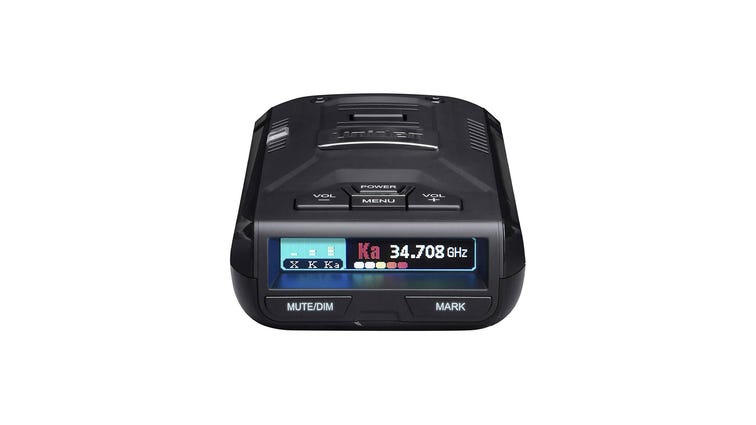

Uniden
If you have less to spend but still want best-in-class performance, the Uniden R3 is Roadshow’s detector of choice. Sharing many of the same internals as the runner-up pick, the R3 was Uniden’s top performer before the R7 showed up, and it remains an impressive package.
The biggest differences from this unit’s big brother are a lack of directional guidance and a less-robust, if still impressive, detection range. As to the latter, the R3 still beats some competitors sold for nearly twice the price including big hitters from Radenso and Escort. The absence of directional arrows is not surprising in this price class, and certainly not a dealbreaker.
The Uniden R3 detects X, K, Ka, MultaRadar and laser and offers customizable tones for each band, voice notifications and a color OLED screen. GPS is also built into this unit and enables speed camera alerts, low-speed muting as well as the capability to set up to 500 manual lockouts by double-pressing the Mute button.
Speaking of controls, this detector is on a short list of window-mounted devices that assign front-facing real estate to frequently used buttons instead of banishing them to the “fumble zone” at the top of the unit, out of sight. That’s a personal pet peeve, but still, kudos to Uniden for positioning the Mute and Mark buttons where they can be easily accessed.

 \n ","topic":"","ttag":"","variant":"","viewguid":"","event":"listicle|image|5","correlationId":"","_destCat":"https:\/\/www.amazon.com\/dp\/B01C0B0RWC","productName":"Best budget radar detector","formatType":"IMAGE","location":"LIST","position":5,"sku":"DFR7","dwLinkTag":"article-body|listicle|image","selector":"#article-body #listicle-86e29944-71fb-4ffa-8a10-da8828975cf5 .itemImage"}}” rel=”noopener nofollow” target=”_blank”>
\n ","topic":"","ttag":"","variant":"","viewguid":"","event":"listicle|image|5","correlationId":"","_destCat":"https:\/\/www.amazon.com\/dp\/B01C0B0RWC","productName":"Best budget radar detector","formatType":"IMAGE","location":"LIST","position":5,"sku":"DFR7","dwLinkTag":"article-body|listicle|image","selector":"#article-body #listicle-86e29944-71fb-4ffa-8a10-da8828975cf5 .itemImage"}}” rel=”noopener nofollow” target=”_blank”>
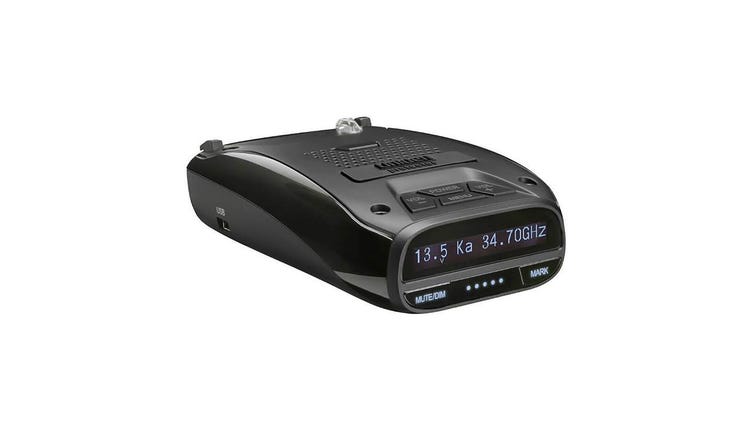

Uniden
And now for something completely… familiar. At the risk of being repetitive, the best budget radar detector available today is yet another offering from the folks at Uniden. The DFR7 initially went on sale in 2016, and despite repeated price drops, it continues to receive firmware updates from Uniden and remains a strong performer, even when pitted against some of the best detectors on the market.
In addition to the standard X, K and Ka radar bands, the DFR7 detects laser. GPS is built into this unit and provides the benefits of low-speed muting to reduce false alerts as well as manual marking of up to 100 lockouts and speed camera alerts. Information is displayed on a monochrome OLED display and voice alerts are available as well.
By all accounts, false alert filtering in the Uniden DFR7 is excellent, and will keep the detector from alarming every time a blind spot monitoring system is in the vicinity. Radar detection range is impressive as well and performs especially well on the 34.7 GHz frequency of the Ka band, according to Vortex Radar.

 \n ","topic":"","ttag":"","variant":"","viewguid":"","event":"listicle|image|6","correlationId":"","_destCat":"https:\/\/www.amazon.com\/whistler-laser-radar-detector-z-19r\/dp\/B00RM8H9PM","productName":"Best ultra-low budget radar detector","formatType":"IMAGE","location":"LIST","position":6,"sku":"","dwLinkTag":"article-body|listicle|image","selector":"#article-body #listicle-5cc7be7a-209c-4dd1-8732-0ce9cc8a9b2a .itemImage"}}” rel=”noopener nofollow” target=”_blank”>
\n ","topic":"","ttag":"","variant":"","viewguid":"","event":"listicle|image|6","correlationId":"","_destCat":"https:\/\/www.amazon.com\/whistler-laser-radar-detector-z-19r\/dp\/B00RM8H9PM","productName":"Best ultra-low budget radar detector","formatType":"IMAGE","location":"LIST","position":6,"sku":"","dwLinkTag":"article-body|listicle|image","selector":"#article-body #listicle-5cc7be7a-209c-4dd1-8732-0ce9cc8a9b2a .itemImage"}}” rel=”noopener nofollow” target=”_blank”>
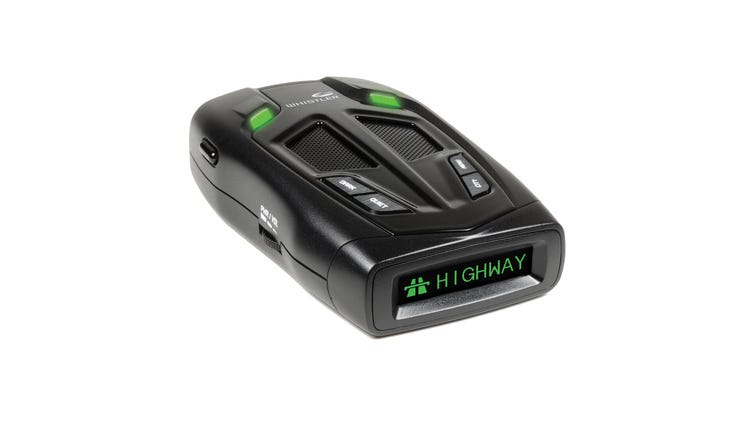

Whistler
For drivers on a razor-thin budget, we present the Whistler Z-19R Plus, a radar detector which may provide some helpful situational awareness, as long as you’re mindful of its limitations.
Radar and laser detection are both on the menu, and the unit displays alerts on a green OLED readout. Voice alerts are optional in both English and Spanish. Filter modes are manually selectable via the City button, which cycles between Highway, City, City 1 and City 2.
GPS is absent here, which means custom location alerts and low-speed muting are unavailable. Detection range isn’t impressive, and it was chatty in our testing, with several false alerts from surrounding vehicles and traffic sensors sneaking past the filters. It definitely alerted me to legitimate threats, and if you can get past the Boy Who Cried Wolf syndrome, it may be worth your money. Still, our recommendation, based on experience and expert advice, is to save up your dollars for a detector with a few more features.

 \n ","topic":"","ttag":"","variant":"","viewguid":"","event":"listicle|image|7","correlationId":"","_destCat":"https:\/\/www.amazon.com\/dp\/B086B88TGR","productName":"Best easy-to-use radar detector","formatType":"IMAGE","location":"LIST","position":7,"sku":"0180009-1","dwLinkTag":"article-body|listicle|image","selector":"#article-body #listicle-0d3e3703-3df7-4e4a-9c93-19e157a65959 .itemImage"}}” rel=”noopener nofollow” target=”_blank”>
\n ","topic":"","ttag":"","variant":"","viewguid":"","event":"listicle|image|7","correlationId":"","_destCat":"https:\/\/www.amazon.com\/dp\/B086B88TGR","productName":"Best easy-to-use radar detector","formatType":"IMAGE","location":"LIST","position":7,"sku":"0180009-1","dwLinkTag":"article-body|listicle|image","selector":"#article-body #listicle-0d3e3703-3df7-4e4a-9c93-19e157a65959 .itemImage"}}” rel=”noopener nofollow” target=”_blank”>
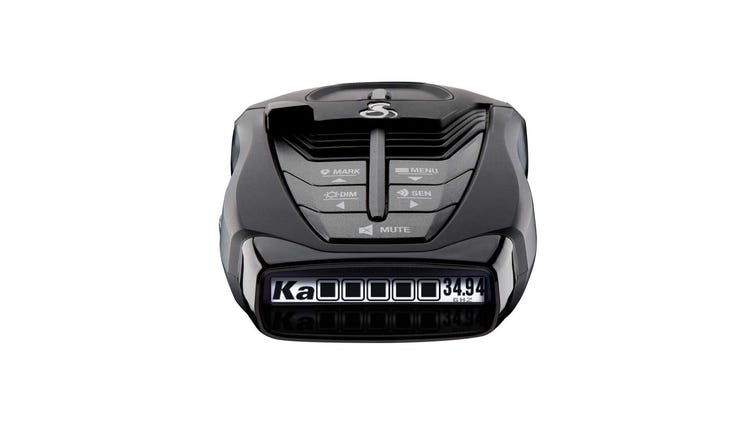

Cobra
If you’re new to the world of radar detectors and don’t want to invest a lot of money or time in learning new terms and technology, we think Cobra’s RAD 480i may be the place to start.
Priced in the sub-$200 range, this unit has the most basic features, but skips other niceties like GPS, RDD immunity or directional arrows. However, it does have one feature which puts it over the top: Bluetooth app integration. At the risk of oversimplification, the 480i can be thought of as “Waze Plus.” Keep reading to find out how.
Once you start running your new Cobra radar detector, you’re immediately granted access to the free iRadar app, available on iOS and Android. The software is essentially the same as the separate Escort Live app accessible by owners of pricier, more precision hardware, as both brands are manufactured by Cedar Electronics. You can even sign into both apps with the same account credentials, as we did in our testing.
Since 2018, these two apps have shared their alert databases. This means, as a Cobra user, you’re getting the benefit of data in the cloud from drivers with more-powerful Escort detectors. The iRadar app itself is colorful and intuitive to use. While the RAD 480i may not have built-in GPS or the best detection range, the app fills in a lot of holes with warnings of upcoming speed traps, speed cameras and more without needing to understand more technical terminology. Cobra users can also report their own police radar sightings by holding down the physical Mark button on the unit for 2 seconds.
Outside of app integration, the Cobra RAD 480i is similarly easy to set up and use with a simple, black and white display and all the familiar buttons. As this model consists of hardware on the more inexpensive end of the spectrum, expect more false alerts and missed hits. Digital Signal Processing provides faster processing for all incoming laser gun signals and rapidly provides accurate alerts. Still, we think this is a good option to consider if money is a major limitation.

 \n ","topic":"","ttag":"","variant":"","viewguid":"","event":"listicle|image|8","correlationId":"","_destCat":"https:\/\/www.anrdoezrs.net\/click-3586864-12699041?sid=%5Bsubid_value%5D&url=https%3A%2F%2Fwww.abt.com%2FEscort-Max-CI-Platform-Radar-Detector-01000274%2Fp%2F124324.html","productName":"Best custom-installed radar detector","formatType":"IMAGE","location":"LIST","position":8,"sku":"","dwLinkTag":"article-body|listicle|image","selector":"#article-body #listicle-c97a320a-ec2d-4a68-af2f-fde17d40e7ac .itemImage"}}” rel=”noopener nofollow” target=”_blank”>
\n ","topic":"","ttag":"","variant":"","viewguid":"","event":"listicle|image|8","correlationId":"","_destCat":"https:\/\/www.anrdoezrs.net\/click-3586864-12699041?sid=%5Bsubid_value%5D&url=https%3A%2F%2Fwww.abt.com%2FEscort-Max-CI-Platform-Radar-Detector-01000274%2Fp%2F124324.html","productName":"Best custom-installed radar detector","formatType":"IMAGE","location":"LIST","position":8,"sku":"","dwLinkTag":"article-body|listicle|image","selector":"#article-body #listicle-c97a320a-ec2d-4a68-af2f-fde17d40e7ac .itemImage"}}” rel=”noopener nofollow” target=”_blank”>
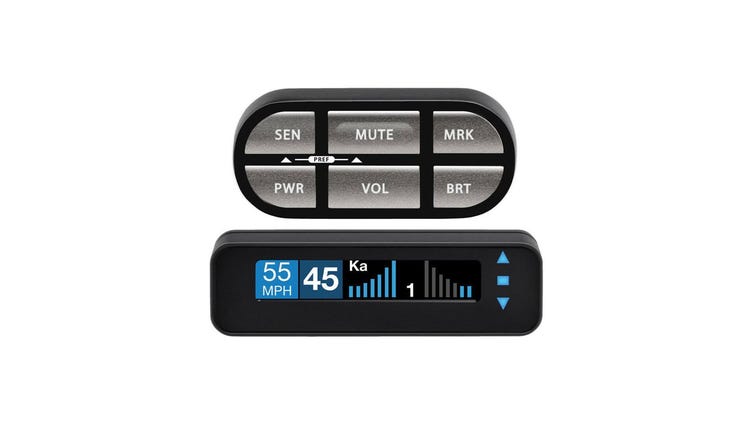

Escort
Many of the options on our list can be discreetly hardwired into your vehicle’s electrical system, but if a box mounted to the windshield, sun visor or rearview mirror just won’t work for you, it’s time to step up to a custom install, otherwise known as a remote radar detector. No matter which solution, you’ll be paying a premium, not to mention the cost of installation. If you’re going to take the plunge, we think the Escort Max Ci is worth your coin.
If you liked the sound of our splurge pick, the Redline 360c, then the Max Ci will be similarly appealing. Once installed, this aftermarket solution integrates GPS, a front radar receiver, as well as display and control modules, which allow you to interface with the system. Additionally, Bluetooth allows the system to integrate with the Escort Live app on your phone.
For additional cost, the system can be expanded to include a rear radar receiver, which enables directional indicators, as well as front and rear sets of laser jammers. The main advantage of a remote radar detector is superior aesthetics, and the Max Ci is an attractive package paired with Escort’s best technology.

 \n ","topic":"","ttag":"","variant":"","viewguid":"","event":"listicle|image|9","correlationId":"","_destCat":"https:\/\/www.alpriorityusa.com\/AL-Priority-Parking-System.html","productName":"Bonus: Best laser jammer","formatType":"IMAGE","location":"LIST","position":9,"sku":"","dwLinkTag":"article-body|listicle|image","selector":"#article-body #listicle-a66ae96a-2d55-43b4-af95-2d98d00cbc60 .itemImage"}}” rel=”noopener nofollow” target=”_blank”>
\n ","topic":"","ttag":"","variant":"","viewguid":"","event":"listicle|image|9","correlationId":"","_destCat":"https:\/\/www.alpriorityusa.com\/AL-Priority-Parking-System.html","productName":"Bonus: Best laser jammer","formatType":"IMAGE","location":"LIST","position":9,"sku":"","dwLinkTag":"article-body|listicle|image","selector":"#article-body #listicle-a66ae96a-2d55-43b4-af95-2d98d00cbc60 .itemImage"}}” rel=”noopener nofollow” target=”_blank”>
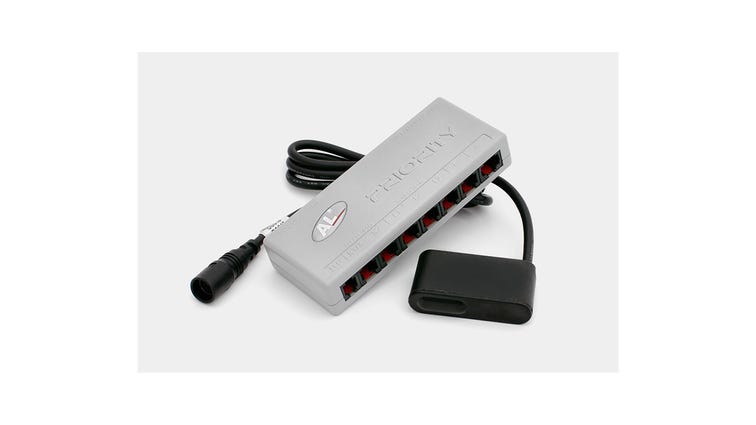

AL Priority
Radar detectors are still effective, as they continue to be widely used across the country, but if your goal is to build an almost foolproof system, it’s time to consider adding laser jammers to the mix. The AL Priority system — the “AL” stands for “AntiLaser” — is considered the gold standard in this category.
ALP requires a custom installation, as all laser jammers do, with at least two sensors up front to detect and fire back a jamming signal at police radar. The system is expandable, maxing out at six sensors, split between front and rear, for necessary coverage, depending on the size of the vehicle.
Bluetooth and Hi-Fi modules are optional for audible alerts, and AL also sells a radar antenna that can be added into the mix if you don’t want to run a separate unit from another manufacturer. As laser jammers aren’t legal in all 50 states, the AL Priority is sold as a “parking system,” and it can be used as such, should you find yourself in a locale where the laser defense abilities need to be disabled. Perhaps not surprisingly, user reviews indicate the parking feature is not where the system shines.

 \n ","topic":"","ttag":"","variant":"","viewguid":"","event":"listicle|image|10","correlationId":"","_destCat":"https:\/\/www.amazon.com\/dp\/B004Y0ZC8M","productName":"Bonus: Best radar detector mount for motorcycles","formatType":"IMAGE","location":"LIST","position":10,"sku":"","dwLinkTag":"article-body|listicle|image","selector":"#article-body #listicle-52b304d4-a8f7-4443-8c04-1c7615d9d872 .itemImage"}}” rel=”noopener nofollow” target=”_blank”>
\n ","topic":"","ttag":"","variant":"","viewguid":"","event":"listicle|image|10","correlationId":"","_destCat":"https:\/\/www.amazon.com\/dp\/B004Y0ZC8M","productName":"Bonus: Best radar detector mount for motorcycles","formatType":"IMAGE","location":"LIST","position":10,"sku":"","dwLinkTag":"article-body|listicle|image","selector":"#article-body #listicle-52b304d4-a8f7-4443-8c04-1c7615d9d872 .itemImage"}}” rel=”noopener nofollow” target=”_blank”>
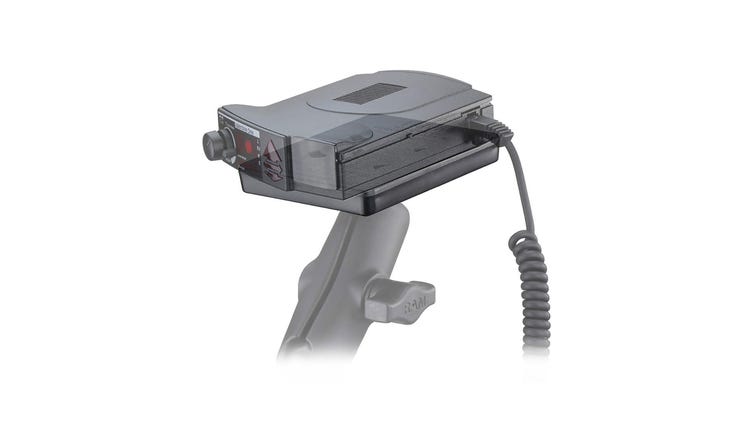

RAM
In the search for the best radar detector for motorcycles, one answer came up over and over: the best radar detector for your bike is the one you’d use in your car. The Valentine One and Escort Redline 360c are both strong performers. So, the question becomes, how do you mod the detector for your motorcycle? One well-regarded part of the solution is the Ram Magnetic Power Plate III for Radar Detectors.
Designed to work as part of Ram’s ball-and-socket mounting system, the Power Plate consists of an adhesive metal plate, which attaches to any flat-bottomed radar detector, and a rubber cradle with two rare-earth magnets. Once paired, the plate holds the device securely, only letting go when the detector is rotated 90 degrees relative to the Power Plate.
Every radar detector motorcycle set-up is going to be different, but I think this is one component that will work well for most riders.
Comparison of the best radar detectors for 2022
| Product name | Price | Pros | Cons | |
| Best radar detector overall | Valentine One Gen2 | $499 | Long-range detection, good false alert filtering, directional arrows, app availability | No built-in GPS, no MultaRadar detection, simplistic interface will be a turn-off for some drivers |
| Best radar detector overall runner-up | Uniden R7 | $480 | Long-range detection, directional arrows, color display, built-in GPS | No Bluetooth or apps |
| Best radar detector if money is no object | Escort Redline 360c | $750 | Long-range detection, directional arrows, automatic GPS lockouts, Bluetooth and Wi-Fi app integration | Price, app occasionally needs rebooting |
| Best midrange radar detector | Uniden R3 | $300 | Affordable, range bests more expensive competitors, built-in GPS with manual lockouts | No directional indicators, shorter range than R7, no Bluetooth or apps |
| Best budget radar detector | Uniden DFR7 | $270 | Frequently discounted, built-in GPS, good false alert filtering | No MultaRadar detection, monochrome display, aging product — updates could be discontinued |
| Best ultra-low budget radar detector | Whistler Z-19R Plus | $135 | Very inexpensive, manual highway and city modes | Poor range, ineffective false alert filtering, no GPS |
| Best easy-to-use radar detector | Cobra RAD 480i | $150 | Affordable, app integration expands limited hardware capability, simple to set up | No built-in GPS, poor range, more false alerts |
| Best custom-installed radar detector | Escort Max Ci | $2,000 not including installation | Aesthetically pleasing, expandable system, built-in GPS, Bluetooth app integration, color display | Price, must be installed by professional, no directional arrows without extra cost, permanent |
How illegal are radar detectors?
Let’s be clear: Yes, radar detectors are about situational awareness, but they’re about one very particular type of awareness, spotting the police before they spot you. So, it’s natural to ask if such a subversion of authority is legal.
The succinct answer is that in the United States of America, unless you are in Virginia, Washington D.C. or on a military base, radar detectors are legal for use in non-commercial vehicles under 18,000 pounds.
For commercial drivers, federal law prohibits the use of detectors in vehicles in excess of 10,000 pounds. However, state laws vary, so check the particulars of the states you’ll be driving through. In Illinois, New York and New Jersey, radar detectors are prohibited in all commercial vehicles, regardless of weight.
While radar detectors are legal for most passenger vehicles, some states do have laws restricting windshield mounts. In California and Minnesota in particular, it is illegal to mount anything to the windshield that might obstruct your view. While these laws aren’t always strictly enforced, you may consider exploring visor-mount options or one of several accessories allowing detectors to mount to your rearview mirror.
One type of electronic device that’s illegal in every state by federal mandate is a radar jammer. Unlike detectors, jammers actually interfere with law enforcement’s ability to read a signal and using one can result in a $50,000 fine in addition to prison time.
On the other hand, laser jammers are not illegal… at least not everywhere. Refer to your specific state’s laws, but at the time of publication, laser jammers are illegal in California, Colorado, Illinois, Iowa, Minnesota, Oklahoma, South Carolina, Tennessee, Texas, Utah and Virginia.
Radar detectors are legal in the majority of the US.
Ben Sanders/RoadshowHow do you choose which radar detector to buy?
If you’re reading this, you probably already know whether you’re the kind of driver who would be well-suited to operating a radar detector. Still, it’s useful to dispense with the notion that radar detectors are just for speed demons.
“Regardless of the type of driver you are, the first question to ask yourself is if accessing more information on the road will be helpful,” says Joseph Sherbondy, the director of the Radar Category for Cedar Electronics, which manufactures the Cobra and Escort brands. “If you’ve ever used programs like Waze or Google Maps to inform driving decisions, then you’d likely benefit from a radar detector.”
From this point, you need to decide how much of a power user you are. “It’s kind of like, do you want to drive a stick or do you want to drive an automatic?” says Bravy. “Some detectors… if you’re tech savvy, sure you can go in and really dial it in and customize it, where other detectors, you can just put it on the windshield, and they do a lot of stuff for you out of the box, and they require less user intervention.”
We’ve found you’ll get a plug-and-play experience from the Cobra RAD 480i, a user-friendly radar detector with expanded capabilities provided via its smartphone integration. Similarly, you’ll get a great out-of-the-box experience from Escort’s Redline 360c, but the gulf between these two detectors’ feature sets and prices is enormous. So, usability is just one consideration.
As with many things, budget plays a big role in finding the right radar detector for you.
Ben Sanders/RoadshowHow much should you spend on a radar detector?
Deciding what you can afford, and what features are worth the cost is key. “You should ask how much information you want, how accurate you want the information to be and how often you want to receive it,” Sherbondy tells us. “This becomes the main driver for deciding between entry-level vs. higher-end detectors.”
Starting at the low end of the radar detector price scale, you immediately come up against a challenge. Is a detector worth buying at all if you don’t have the money to invest in a product with at least mid-level quality and reliable product support? Bravy would argue there’s a point of diminishing returns.
“You’ve got the really inexpensive, cheap ones, and they technically work, but the range is really poor, and they wind up giving a lot of false alerts,” he says. “And so, once you start looking into the mid-tier detectors or upper-tier detectors, that’s when you start getting good range that really offers solid protection.”
While there’s an ultra-low budget option on our list, it’s worth asking yourself if you have the fortitude to deal with the sub-par range and false alarms that lower-tier hardware delivers. In our testing, such units became more frustrating than useful. Given the choice, I’d suggest opting for a free app like Waze and save your pennies for quality mid-tier equipment. We consistently ran Waze alongside our detectors, and it frequently identified speed traps that didn’t set off alarms on our detectors and vice versa.
Differences between mid-tier and top-tier radar detectors are less pronounced. Pricier models will get you niceties like directional arrows, which help you locate the source of radar signals. Bluetooth, Wi-Fi and MultiRadar detection are also generally only found in higher-end units.
The Cobra RAD 480i is a simple and affordable radar detector.
Ben Sanders/RoadshowWhat features should you look for in a radar detector?
Whether you shop in a brick-and-mortar store or online, you’re going to see long, bulleted lists that contain a dizzying array of features. Here are the things to actually pay attention to, according to our radar detector experts.
“So for me, number one, gotta have long-range performance,” Bravy says.
Sherbondy concurs, “If you’re looking at higher-end detectors, try selecting one with the best possible detection range and false alert filtering and that can be updated over time.”
The longer the detection range, the more time you have to safely react to a hidden officer, and if you have good false alert filtering on your side, you can be sure you’re not riding the brakes for nothing.
“Smart cruise control, blind spot monitoring, all that kind of stuff. Those are also emitting radar,” according to Bravy. “Having something with really good false alert filtering… that has a variety of different false alert filters is going to make a really big difference.”
Additionally, to take false filtering to the next level, GPS should definitely be on your wish list. “If you’re looking to receive the most accurate alerts, you should only select detectors that will automatically learn to reject repeated false alerts,” Sherbondy says. “GPS tracking and intelligence can reduce false alerts from collision avoidance systems or blind spot monitoring systems as well as learn to remember false alerts from specific locations.”
“If you do any driving in cities, definitely you’re going to want a detector with GPS,” says Bravy. In addition to auto or manual lockouts, GPS enables low-speed muting, which means less physical toggling between Highway and City modes to silence falsing from automatic store doors and roadside speed signs.
Escort’s Redline 360c is the radar detector for you if you’re working with a plump budget.
Ben Sanders/RoadshowAre all the features useful?
As you’ve seen, the recipe for a good detector comes down to a handful of qualities and features. Yet, one of the boxes our tester units came in was swathed in a list of marketing claims 29 items long, the first of them being “Maximum Performance.” No, it wasn’t one of our winners.
Some features sound impressive until you realize it’s nothing unique. “360-degree detection,” Bravy says, listing some of his favorite non-features. “Every detector, every detector can detect from all different directions.” And lest you think this claim is reserved for units with locating arrows, it’s not. The most inexpensive radar detectors will still make a big deal of their ability to sense signals from all directions even though they can’t point you in the direction of the source.
“Also people say, ‘we can detect the latest instant-on radar guns,'” Bravy continues. “Every gun supports instant-on, and all that means is you tell the gun to transmit or not… that’s kind of like a TV you can turn on and off.” Similarly, manufacturers will tout a detector’s POP technology. Read on below for more insight on this overblown claim.
On the other hand, some features seem to have genuine value until you realize not all technology is created equal. Take RDD immunity, for example, a feature that’s a must-have for many buyers.
“For drivers who want to remain discreet, manufacturers have introduced stealth capabilities to go undetected,” Sherbondy explains. “Some companies report having stealth in their detectors, but in many cases, this approach hard codes the technology into the device, limiting its effectiveness for the future.” As technology in the radar arms race evolves, hard coded detectors are left behind.
Also among the Claims of Shame? VG-2 detection, safety warning system alerts and laser detection. “That’s an interesting one,” Bravy says of now-ubiquitous lidar sensors, “…but it’s not really useful at helping you avoid tickets.”
People who do lots of city driving will want an GPS-enabled radar detector.
Ben Sanders/RoadshowAre radar detectors future-proof?
A radar detector can be a big investment, especially if you’re purchasing a top-performing window-mount unit or a custom installed detector, and the longer you plan to keep it, the more future-proof it should be. Here are a couple of features that aren’t a big deal now, but may compromise your detector down the line if it doesn’t have them.
The first of these features is deceptively bland, but perhaps the most important thing to look for. “Software updates,” says Sherbondy. “Specifically, a device that can be easily updated via (over-the-air) Wi-Fi updates or through a hardwire connection to your laptop… This will ensure that you’re getting the best performance out of your detector even as new car technology that may cause false alerts is introduced.”
A good way to check for this is to visit the support page of the manufacturer’s website and look for the radar detector you’re researching. Check for the frequency and recency of available updates in the Downloads section, being mindful that if it’s a brand-new product, there may not be many updates yet.
Bravy agrees that regular updates are the first step to futureproofing a detector. “The second thing, in terms of new technology, that comes back to photo radar … automated speed enforcement,” he says. “Companies have had to adapt and build in new capabilities to detect these new photo radar guns that are trying to not be detected.” When looking for photo radar features, note that it may also be called MultaRadar, MRCD or MRCT. To learn more about it, see below.
One question hangs in the air. With the advent of lidar and the inability of detectors to provide any advance warning of laser guns, are radar detectors doomed for the dustbin?
Bravy chuckles at this suggestion. While the radar-lidar mix varies by location, in Seattle where he performs extensive testing of radar detectors and laser jammers, he estimates radar usage at around 90%. There are good reasons why radar will remain a significant part of the law enforcement toolkit for some time to come.
“Radar can be used while officers are moving,” Bravy explains. “Whereas laser can only be used when the officer is stationary.” Add to that the fact that new types of radar are still being developed such as the aforementioned photo radar. “I don’t see officers going away from radar. If anything, they’re just upgrading to newer radar guns.”
Radar detectors that feature software updates are important for future proofing it.
Ben Sanders/RoadshowHow do speed guns work?
Speed detection technologies can be broadly separated into two categories: Radio Detection And Ranging (radar) and Light Detection And Ranging (lidar). Both work by shooting a signal, either radio waves or light pulses, toward a moving vehicle and measuring the change over time in the signals bouncing back.
In both technologies, this is a phenomenon known as doppler shift. As a vehicle moves closer to the radar-emitting source, the reflected waves return at a higher and higher frequency. A radar gun calculates this increasing rate and returns a figure in miles per hour. Though they work on the same basic principle, radar is comparatively sloppy next to lidar, which we will explore later on. Meanwhile, it’s the lack of precision in radar guns that gives radar detectors their advantage.
How does a radar detector work?
The term “radar detector” is a mostly accurate catch-all name for devices designed to detect the presence of law enforcement speed monitoring. Once upon a time, a radar detector was exactly that: a simple box which alerted the driver to the presence of stray radar signals, likely originating from police elsewhere in the area.
Now radar detectors are a mix of technologies such as GPS, laser detection, filtering algorithms, data from the cloud and, yes, good old-fashioned radar detection, with the goal of accomplishing the same thing.
At the heart of a radar detector is a superheterodyne receiver, which can pick up electromagnetic radiation emanating from a police officer’s doppler gun. The reason that detectors can warn of police presence sometimes miles in advance is because radar guns are inexact. As they shoot out a signal, the wave spreads beyond the intended target and proceeds to bounce off other surrounding objects, sending it in unintended directions.
Radar detectors sense this stray radiation and are able to identify it as the kind of radiation likely to have originated from speed enforcement radar. This information is conveyed to the driver via visual and auditory alerts, which identify the type of radar, its strength and depending on the hardware, the direction of its origin relative to the vehicle.
Whistler’s Z-19R Plus radar detector is the best bet for budget minded shoppers.
Ben Sanders/RoadshowWhat do the different bands mean on a radar detector?
The information coming from your radar detector can get technical. The more you’re willing to learn, the more you’ll understand what it’s trying to tell you. Most detectors can be boiled down to beeping = bad, but to get any real use out of the device, you need to have a basic understanding of the types of radar bands being detected and whether or not they’re likely to represent a genuine threat.
X Band: Though it has been retired by the majority of jurisdictions, this is the oldest police radar band still in use. Law enforcement operates exclusively on the 10.5 GHz frequency, and the equipment that transmits X band is bulky due to the larger antennas required. While X band is less affected by poor weather, it’s also easy for detectors to pick up at a distance. You can start to see why it’s been mostly discontinued.
X band can still be found in use in rural areas and generally underfunded regions where the cost to upgrade equipment remains prohibitive. Outside of these types of areas, it’s reportedly still widely in use in Ohio and New Jersey. Many detectors allow you to disable X band detection altogether since it’s rare to encounter legitimate law enforcement using it.
K Band: This is harder to detect from long distances and requires a lower power output from police radar gun equipment, so it’s easy to understand why K band was adopted by law enforcement. Police operate exclusively in the 24.125 to 24.150 GHz range of the K band. Frustratingly, many other radar sources operate in this range including automatic doors and BSM systems on other vehicles. This noise is what makes the K band especially problematic for radar detectors, and it’s the reason good false filtering is a must.
Ka Band: Officially approved for use by the FCC in 1983, the Ka band is the most recent frequency range to be employed by US police departments for speed radar. Ka band guns use even smaller antennas than either X or K band and less power as well. Among the bands, Ka is the most difficult to detect at a long distance as its guns fire a narrower beam and operate at lower power.
If there’s an upside, it’s that few other sources of radar operate in the Ka band. So when you receive a Ka alert from your radar detector, it almost always originates from speed enforcement and should be taken seriously from the jump.
MultaRadar: This is not a separate band as much as it is a new technology. MultaRadar, which is also known as MRCD, MRCT or photo radar, uses the K band, but instead of remaining on one frequency as in the examples above, it sweeps up and down the frequencies within a given range. This is called frequency modulation (as opposed to traditional continuous wave radar), and it’s invisible to radar detectors that aren’t equipped to pick it up. In cases where it can be detected, the window of warning is extraordinarily small.
Photo radar is not yet ubiquitous throughout the United States, but it is widely used in Europe and Canada, and is increasingly coming into use stateside. In Canada, it’s frequently set up in an unmarked truck, which photographs speeding vehicles from behind to capture their license plates so a citation can be issued via mail. Here it can be found in cities like New York and Chicago.
Radar band cheat sheet: Here’s a simple TL;DR for radar bands and how you should react if you’re alerted to each type.
- X Band: Start slowing down in Ohio, New Jersey or rural areas, otherwise proceed with caution.
- K Band: Be prepared to slow down, especially if your detector has good filtering. If not, pay special attention to your surroundings for sources of radar. There are many false alerts on this band.
- Ka Band: This is almost certainly coming from law enforcement. Start slowing down immediately. If you have a quality detector, you may have more lead time.
- MultaRadar: Slow down immediately and proceed until the alert has completely quieted. Photo radar can be located in an unmarked vehicle or discreetly integrated into municipal infrastructure.
Learning about the different bands helps determine how serious a warning is.
Uniden/Valentine/WhistlerWhat are some common set-up mistakes?
You’ll need to check your manual’s instructions for setting up your radar detector, but here are some tips that may differ from the manufacturer’s instructions. Follow them at your own discretion.
Placement: Most laser-radar detector combination units will instruct you to mount the detector as low as possible on the windshield without obstructing the sensors behind anything solid like the windshield wipers. This is likely to optimize the chance your detector will pick up laser if shot, since laser guns aim at the grille or headlights.
We recommend optimizing your radar detector for picking up radar because laser detection isn’t useful for the reasons we’ve cited. To get the best possible radar range, you should mount your detector as high on the windshield as you can without obstructing the sensor.
Aiming: The angle at which you mount it matters as well. “Most people just stick it on the windshield and call it a day, or they stick it on the side of the windshield so your radar detector points off at a weird angle,” Bravy says. For proper detection, the mount should be adjusted so that it is parallel to the road surface. “You’re not trying to detect radar from the International Space Station.”
Power: While certainly not wrong, per se, if you’re committed to using your radar detector on a regular basis, consider hardwiring the unit. Some higher-end detectors even ship with the cabling for a permanent install. “Plug it into your fuse box or power it off your rearview mirror,” Bravy recommends. “That way you don’t have a cable hanging down your dash. It makes it a little bit cleaner.”
Settings: In terms of configuration, Sherbondy says drivers should get to know their detector for the advanced and customizable system it is. “They often don’t spend enough time at the start of the process to learn basic detector functions to optimize their experience,” he says. “Take the time to understand your device’s unique options and customize them to your driving style — it will significantly impact your long-term experience.”
The internet is a treasure trove of people who want to help drivers optimize their detectors. RDForum.org is a great resource as well as other enthusiast websites like VortexRadar.com, which provides configuration tutorials for most popular makes and models.
Bravy offers up one easy thing most users can do to immediately improve their radar detector experience. “In most places you can turn off X band,” he says. Do a little research, and you can quickly find out if you live in one of the few places where this old tech is still in use.
For the best radar detection results, mount your detector as high as possible in the windshield without obstructing the sensors.
Ben Sanders/RoadshowWritten for Roadshow by Ben Sanders.


